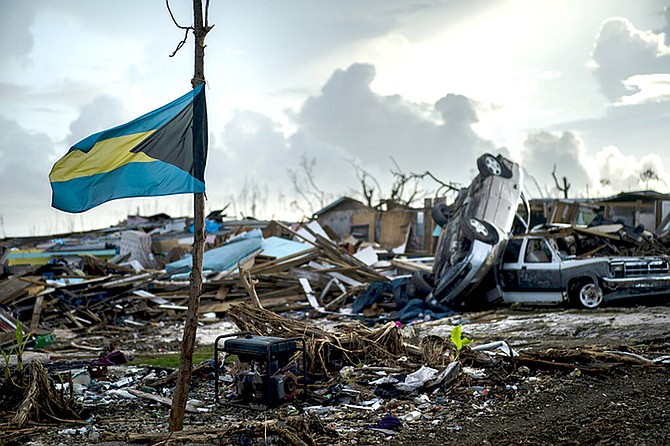A Bahamas flag flies tied to a sapling, amidst the rubble left by Hurricane Dorian in Abaco in September. (AP Photo/Ramon Espinosa)
By NEIL HARTNELL
Tribune Business Editor
nhartnell@tribunemedia.net
Hurricane Dorian left almost 3,000 homes “uninhabitable”, a newly-released report has revealed, as it inflicted $1.487bn worth of damage on the housing sector in Abaco and Grand Bahama.
The long-awaited assessment of the category five storm’s financial impact, produced by the Inter-American Development Bank (IDB) and other multilateral agencies, projected that this nation has taken a total $3.438bn hit through physical damage, economic/revenue losses and “additional costs” related to issues such as the Grand Bahama oil spill and environmental damage.
Housing, not surprisingly, was identified as the sector most impacted by Dorian with around 9,000 homes - representing more than 11 million square feet of physical property - damaged to some degree by its winds, storm surge, falling trees and flying debris.
“Approximately 9,000 homes, and in excess of 11 million square feet of structures, have sustained some damage on the two islands. On Abaco, more than 75 percent of the dwellings were somehow affected, and approximately 57 percent of the houses were severely damaged. Central Abaco (Marsh Harbour), Treasure Cay, and Hope Town were the most affected locations,” the joint report found.
“Damage to the housing sector on the islands of Abaco and Grand Bahama is estimated at $1.48bn, 88.9 percent of which took place on Abaco. Losses in the housing sector are attributed to the interruption of accommodation and rental services due to severe damage or destruction of the house, making it temporarily or permanently uninhabitable. The assessment team estimated losses at $56.8m resulting from 2,894 homes left uninhabitable after the hurricane.”
The report, a team effort between the IDB, United Nations’ Economic Commission for Latin America and the Caribbean (ECLAC), and the Pan-American and World Health Organisations (PAHO and WHO), said a further $45.9m in additional costs will be incurred in removing debris and demolishing unsafe structures.
The document provides a further insight into the economic and social blow Dorian has inflicted upon The Bahamas, especially Abaco and Grand Bahama, as its scope includes not just the physical damage to homes, businesses and utilities infrastructure but the likely economic and income losses caused by commercial activity - especially in the former island - coming to a complete halt as well as clean-up/recovery costs.
“In total, 31 public buildings (excluding schools, hospitals/clinics and shelters that were assessed in other sectors) and government offices were affected,” the report said. “Damage to the public building sector is estimated at $10.6m. Additional costs to demolition and debris removal in public buildings are estimated at $1m. There was no losses related to public buildings.”
It estimated that some 29,472 persons were impacted by damage to their homes and assets as a result of Dorian, with Abaco bearing the brunt of what it described as almost $1.6bn in damages to the “social sector” - which was classified as education and health, as well as housing.
“Damage in the social sector was $1.6bn; 85.3 percent took place on Abaco,” the assessment report found. “Ninety-three percent of the damage was in housing, 4.6 percent in education while 2.4 percent occurred in the health sector. Approximately 93.8 percent of the damage in the social sector happened to private property, and the remaining 6.2 percent in public property.
“Losses for the social sector are estimated to be $92.4m. Of those, $65m were in housing, $21.4m in health and $6m in education.” The IDB/ECLAC report warned that the healthcare system’s capacity to provide services “has been significantly hampered” on both Abaco and Grand Bahama due to the loss of infrastructure, medical supplies, equipment, vehicles and personnel.
“The estimated damage in infrastructure, medical equipment, furniture, supplies and others to the health sector on Abaco and Grand Bahama attributable to Hurricane Dorian has been estimated at $37.7m,” the report said. “A total of $21.4m is the estimated cost of health services operations disruption.
“The disruption covers three time periods: Before, during and after the hurricane. Additional costs are related to the emergency response and provision of temporary relief, and are estimated as $5.3 million.”
With Dorian’s total healthcare sector impact pegged at $64.4m, the IDB/ECLAC assessment added that 45 educational facilities suffered “varying levels of damage” impacting some 10,546 students and 796 teachers.
“Seven schools were altogether destroyed,” it confirmed. “The widespread damage to educational facilities amounted to $72m. Losses in the sub-sector, which comprises the estimated value of lost instruction time along with the value of tuition refunds for students no longer returning for post-secondary level education, totalled $6.8m.
“The remaining costs included additional costs incurred during the recovery efforts, which amounted to $21m. They include the removal of rubble, school furniture to accommodate re-assigned students and teachers, special equipment to conduct classes, fencing, security, school meals, payment of grants, security, psychosocial support to teachers and staff, enrollment fees and costs associated with the enrollment drive conducted by the Ministry of Education for displaced students.
“The estimated costs across the two islands were equally distributed despite the student and teacher population on Abaco being significantly smaller than that of Grand Bahama; an indication of the magnitude of the damage on Abaco. Public sector institutions incurred the brunt of the costs across the affected islands, with a total estimated cost of $74m.”





Comments
Use the comment form below to begin a discussion about this content.
Sign in to comment
Or login with:
OpenID